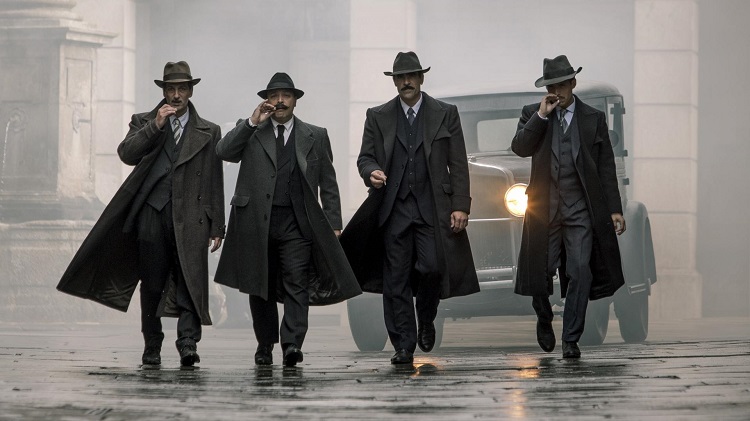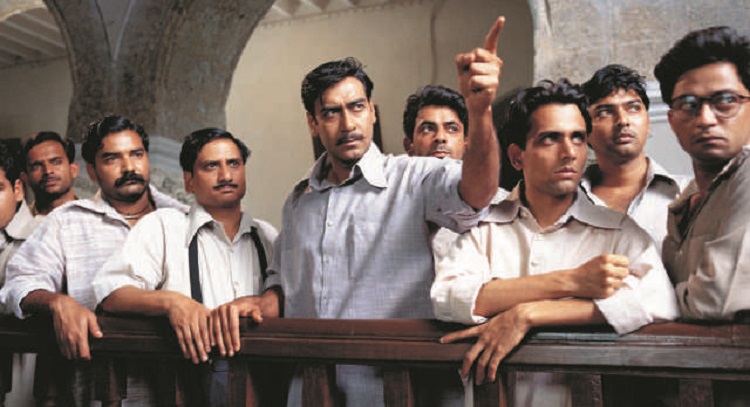Subtext | The Turbulent Twenties
A lot of history textbooks skip right over the period between the two World Wars as if little of importance happened in those two decades. Those that do mention them generally only hit the highlights – the death of Lenin in Russia, the US market crash in the 1930s, that sort of thing. But in fact the world a hundred years ago was a very unstable place. These three films set on three different continents in three very different countries all share one thing in common – they give us a window into how events all around the world were laying the foundation for the century to come.

The Great Magician (2011)
The first of these films is set in China. As we discussed when talking about Detention, the foundation of modern China was more than a little messy. For centuries it was ruled by the Qing dynasty, but in 1912 they were overthrown in the Xinhai Rebellion. Yuan Shikai, a former general, made himself President of the Republic of China (though he was actually a dictator). In 1915 he tried to formally make himself Emperor, but his death in 1916 put an end to that. It also led to the complete collapse of government, causing 12 years of anarchy before the Kuomintang forcefully reunited the country. This period, when various local rulers vied for power, is called the Warlord Era. It’s a popular time period for fiction, similar in tone to Mad Max-style post apocalyptic fare with the trappings of civilisation but none of the stability. The Great Magician is one such film.
The “great magician” of the title is Chang Hsien, a stage magician in the classic Western style. At the time during the 1920s stage magicians like Houdini were extremely popular worldwide. China was considered an unknown land, so some of these performers added Chinese trappings to their performances. In some cases they were actually Chinese-born (like Chee Ling Qua, who used the stage name Ching Ling Foo), others were not and used “yellowface” makeup (like William Ellsworth Robinson, who used the name Chung Ling Soo and stole Chee Ling Qua’s entire act). Chang Hsien is going in the opposite direction – he has the top hat, white shirt and black suit of a traditional westerner. He’s played by Tony Leung Chiu-wai, one of Hong Kong’s most accomplished actors. (His most recent Hollywood role was as Shang-Chi’s father in the MCU.) Chang Hsien gets caught up in a scheme by rebels to kidnap one infamous warlord, which is complicated when he finds out the warlord Lei Bully (played by Lau Ching-wan) is courting his ex-girlfriend, Liu Yin (played by Zhou Xun). Things only get more complicated from there, with a plot as full of misdirection and intrigue as a magic show.
The film is written and directed by Derek Yee Tung-Shing, who was an actor for Shaw Brothers in the 70s and 80s before moving more into directing in the 90s. He’s not that well known in the west, with his best-known film probably being hyper-violent Jackie Chan flick The Shinjuku Incident. His most well-received film in his home country was 2004’s One Nite In Mongkok. The only cast member to be nominated for an award was Zhou Xunyun, who we’ve seen previously in The Yin Yang Master (the one based on the video game). It’s a shame it didn’t get more recognition; it’s a fun film that does a good job of developing all three of its central characters. The effects are nicely done and it has some fun with the period-accurate magic tricks, resulting in a light but enjoyable little adventure film.

Gun City (2018)
Gun City is a Spanish historical noir thriller originally released under the title La Sombra de la Ley (“The Shadow of the Law”). It’s set in Barcelona in 1921 – a turbulent time for Spain. In the opening, a train is robbed despite having soldiers on board who are gunned down by the attackers. The next day, a stranger (played by Luis Tosar) arrives at the police station. There he joins the local Information Brigade squad as a transfer from the Madrid branch. The Information Brigade are a force set up to deal with anarchists, who are suspected to have robbed the train, though it turns out they are far more involved in running protection rackets against local businesses. The fact that the train was carrying weapons, and that the governor gives them 72 hours to find them before he declares martial law, focuses their attention on the case. Throw in a crimelord running a sleazy cabaret, a local union leader and his firebrand anarchist daughter, and street protests on the verge of igniting into full-blown revolution. The result is a city on the verge of explosion.
The 1920s were a rough time in Spanish history. Leftwing agitators dreamed of making it the next Soviet state, while the government used any brutal measures possible to stop that happening. Twelve years before film is set a worker’s riot in Barcelona had been ruthlessly suppressed by the military, resulting in 100 deaths. The trigger had been the government mobilising its reserves to go fight in the colony of Morocco. One key event in the background of Gun City is the battle of Annual, a disastrous defeat for the Spanish army that drove them out of Morocco. Two years after this film is set a military coup would install a dictatorship that suppressed all dissent, but it wouldn’t halt the country’s slide towards the civil war that erupted in the 1930s. At the start of the war Barcelona was an anarchist stronghold, until their Stalinist and Republican “allies” forcefully took control of it. After Franco won the civil war the city was subjected to retribution that left scars which linger to the current day.
Gun City is a film that, true to the noir spirit and the messy history of the time, has no real “good guys”. It’s a beautiful film which deservedly won awards for cinematography and costuming as well as Mestre Mato awards for its director and lead actor. The cabaret run by “the Baron” (played by Manolo Solo) is a lovingly recreated den of sin, while the movie’s action setpieces are appropriately brutal and messy. It didn’t make its budget back at the box office, but it was partially funded by Netflix who took over the international distribution, so it doesn’t seem to have been regarded as a flop. It’s recommended to fans of noir, crime drama, historical films, and men with amazing facial hair being very angry with each other.

The Legend of Bhagat Singh (2002)
Excellent facial hair is also on display in The Legend of Bhagat Singh, a historical drama set in the Indian independence struggle of the 1920s. Bhagat Singh was born in 1907 in a village in the Punjab (ironically in what would later become Pakistan), the son of a Sikh couple. His father and uncle were both active in the non-violent resistance movement led by Mahatma Gandhi, and Bhagat attended an independent Indian college founded by Lala Lajbat Rai. It was at college that he became a socialist and joined the Hindustani Socialist Republican Association. After a protest was brutally suppressed and Rai (who had led it) died of his injuries, the HSRA decided to turn to “the propaganda of the deed”. They conspired to kill Superintendent Scott (who had ordered the suppression) but instead killed his deputy, John Saunders, on 17th December 1928.
The killing was condemned by the non-violent movement and was unpopular at first, plus Bhagat was identified and had to go on the run. Over the next few months he went around rural villages preaching revolution (with the aid of a magic lantern show) and became for many people the face of the HSRA. In 1929 he proposed a plan to the party’s leadership, to symbolically bomb the Central Legislative Assembly in protest at a public order bill and us the trial to spread their message to the people. Though they knew he was taking a risk because he was still wanted for murder, the plan went ahead. This didn’t work out as they planned, but Bhajat Singh got a high profile when he began a hunger strike to have him and the other arrested HSRA members recognised as political prisoners. After this, when he was put on trial for murder he and the defendants were able to play to the press quite effectively. This prompted a Special Tribunal of dubious legality to speed up the case, resulting in him and two others being sentenced to death. They were hanged on 23rd March 1931, and Bhagat Singh (who was still only 23 years old) became one of the most famous martyrs to the cause of Indian independence.
The Legend of Bhagat Singh is not a historical recreation, and it’s not interested in being one. It’s a hagiography and not a biography, as one would expect – it is after all the Legend of Bhagat Singh. Rajkumar Santoshi (who wrote and directed) is telling us not who Bhajat Singh was, but who he should have been. (There was in fact some controversy around this, with the children of one of Bhagat’s brothers objecting to some of the changes. On the other hand, a surviving brother endorsed the film.) The other great theme of the film is whether violence in self-defense can be justified, with one scene structured as a debate between Bhajat and Gandhi (through some clever cuts between the trial and Gandhi giving speeches). Ajay Devgan, who was cast for looking like Bhajat, turns in a mesmerising performance. This was the year his career took off, and this film was a large part of it. (Recently he had a role in another film about Indian revolution, playing Rama Raju’s father in RRR.) The rest of the cast are equally as committed to their roles. Especially notable is D Santoshi in his first ever film role. He was cast for his resemblance to Shivram Hari Rajguru, one of the men hanged alongside Bhajat Singh, and gives a great performance that starts out as comic relief and ends up as a heroic martyr.
The Legend of Bhagat Singh got a lot of critical praise on release (and won several awards), but sadly its box office didn’t quite measure up. (In part this was due to another film about Bhagat that released the same weekend, 23rd March 1931: Shaheed.) The director and actors continued to champion it throughout their career however, and it’s now considered a classic of Bollywood. It may not be historically accurate, but like all three of these films it gives us a window into the world of a century ago; a reminder that history never stops happening and that the time between wars isn’t always peaceful.
Images via IMDB

